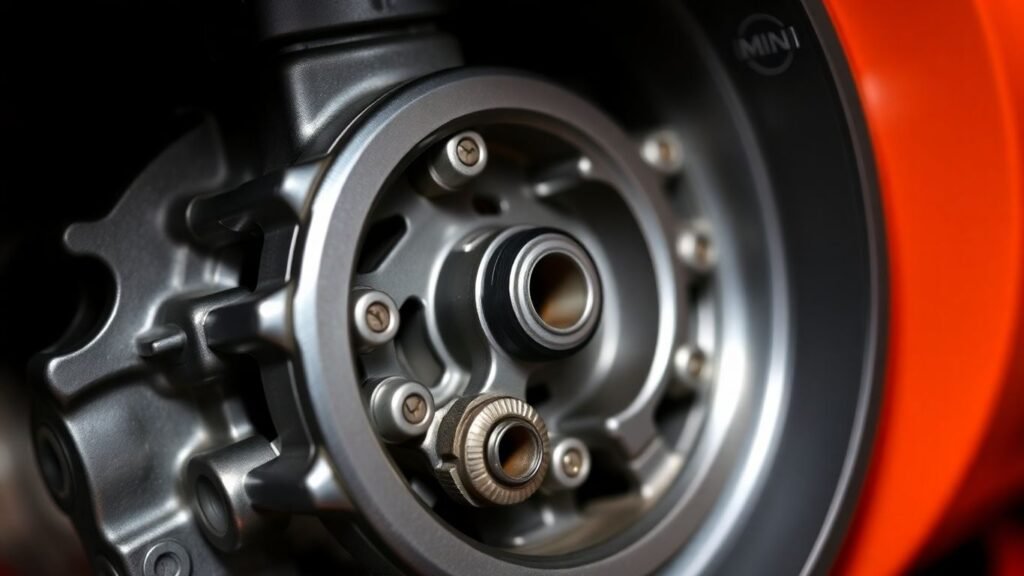So, you’ve got a Mini Cooper and it needs a little TLC. Instead of breaking the bank on brand-new parts, have you thought about going the used route? It’s a pretty smart move, honestly. You can save a good chunk of change and still get quality components for your car. We’re talking about parts that are often just as good as new, but way easier on your wallet. Plus, it’s a good way to be a bit kinder to the planet. Let’s figure out where to buy a second hand Mini Cooper gearbox and what to look out for.
Key Takeaways
- Buying a second hand Mini Cooper gearbox can save you a lot of money compared to new ones.
- You can often find genuine OEM gearboxes from vehicles that weren’t damaged in the area you need.
- Using second-hand gearboxes is a more environmentally friendly choice.
- Look for gearboxes from specialized Mini wreckers or reputable online sellers.
- Always check the gearbox’s condition and match part numbers before you buy.
Where To Buy A Second Hand Mini Cooper Gearbox
Understanding Your Mini Cooper Gearbox Needs
Figuring out which gearbox your Mini Cooper needs can feel like a puzzle. You’ve got different models, years, and even engine sizes, all of which use specific gearbox types. For instance, a 2003 Mini Cooper R50 with a 1.6 engine might use a different gearbox than a 2008 Cooper S. It’s super important to get the part number right to avoid buying something that won’t fit. Think about whether you need a manual, automatic, or maybe even a more specialized performance gearbox. Knowing your car’s exact specifications, like the VIN, can really help narrow down the search and save you a lot of hassle later on.
The Benefits of Opting for a Used Gearbox
Buying a used gearbox is often a smart move for your wallet. New gearboxes can cost a pretty penny, and honestly, a well-maintained used one can perform just as well. It’s a way to get your Mini back on the road without breaking the bank. Plus, it’s a more environmentally friendly choice, giving a perfectly good part a second life instead of it ending up in a landfill. It’s a win-win, really.
Identifying Quality Used Gearbox Components
When you’re looking at used gearboxes, you want to make sure you’re not getting a dud. Look for sellers who can provide some history or at least a warranty. Checking for signs of wear, like rust or damage to the casing, is a good start. If possible, ask if the gearbox was tested before being removed from the donor vehicle. Some places might even offer a limited warranty, which is always a good sign that they stand behind their products. It’s all about finding a balance between cost and confidence in the part you’re buying.
Specialized Retailers For Mini Cooper Gearboxes

Dedicated Mini Cooper Wreckers
When you’re on the hunt for a used Mini Cooper gearbox, hitting up specialized Mini wreckers is often your best bet. These places live and breathe Minis, so they’re usually stocked with a variety of gearboxes from different models and years. They know their stuff, which means they can often help you pinpoint the exact gearbox you need, whether it’s for a classic R50 or a newer model. Plus, they’re more likely to have parts that have been inspected or even tested, giving you a bit more confidence in your purchase.
Online Marketplaces For Used Parts
Don’t underestimate the power of the internet. Websites like eBay, specialized auto parts forums, and even dedicated used parts marketplaces can be goldmines. You’ll find sellers from all over, offering everything from complete gearboxes to individual components. It’s a good idea to compare prices and seller reviews carefully. Some platforms even offer buyer protection, which is a nice safety net.
| Part Type | Typical Price Range (USD) |
|---|---|
| Manual Gearbox | $300 – $800 |
| Automatic Gearbox | $500 – $1200 |
| CVT Gearbox | $600 – $1500 |
Always ask for the gearbox’s mileage and any known history before buying. A little bit of digging upfront can save you a lot of headaches later on.
Local Auto Recyclers With Shipping Options
Think local, but with a wider reach. Many auto recycling centers, or junkyards as some call them, have online catalogs and offer shipping. If you have a good local recycler you trust, check their inventory online. If they don’t have what you need immediately, they might be able to source it for you. Shipping can make it convenient to get a part from a recycler that’s a bit further away, especially if they have a better selection or price.
Key Considerations When Buying A Used Mini Cooper Gearbox

So, you’re looking to snag a used gearbox for your Mini Cooper. Smart move, really. It can save you a pretty penny compared to buying new, and honestly, a lot of these used parts are still in great shape. But, you can’t just grab the first one you see. There are a few things you really need to think about to make sure you’re not getting a dud.
Verifying Part Numbers and Compatibility
This is probably the most important step. You absolutely have to make sure the gearbox you’re looking at is the right one for your specific Mini Cooper model and year. They might look similar, but even small differences can mean it just won’t fit or work correctly. Always double-check the part number on your old gearbox and compare it with the one you’re buying. If you’re not sure, ask the seller or a mechanic. Getting this wrong means you’ve wasted time and money.
The Importance of Warranties and Return Policies
When you buy a used part, especially something as complex as a gearbox, a warranty is your best friend. It’s like an insurance policy. If the gearbox has a hidden problem that shows up soon after you install it, a good warranty will let you return it or get it fixed without costing you extra. Always ask about the seller’s return policy too. What happens if it doesn’t work? Can you send it back? Knowing this upfront can save you a lot of headaches.
Assessing the Condition of the Gearbox
Don’t just take the seller’s word for it that the gearbox is in good shape. If you can, try to inspect it yourself. Look for any obvious signs of damage, like cracks in the casing or leaks. Check the fluid if possible – is it clean or does it look burnt and gritty? Sometimes, sellers will provide a video of the gearbox working, which is a good sign.
It’s always a good idea to ask for the mileage of the car the gearbox came from. Lower mileage generally means less wear and tear, which is exactly what you want when buying used. Don’t be afraid to ask questions; a reputable seller will be happy to provide details.
Here’s a quick rundown of what to look for:
| Feature | What to Check |
|---|---|
| Casing | No cracks or major damage |
| Fluid | Should be clean, not dark or gritty |
| Seals | Look for signs of leaks |
| Shifting Action | If possible, check for smooth engagement (when stationary) |
| Seller Reputation | Look for reviews or feedback if buying online |
Exploring Different Mini Cooper Gearbox Types
Mini Coopers have come with a variety of gearboxes over the years, and picking the right one for a replacement is pretty important. It’s not just about getting a gearbox that fits; it’s about getting one that matches how you like to drive and what your Mini needs.
Manual Transmission Options
For those who really enjoy being connected to their car, the manual gearbox is the way to go. These have been around since the early models, like the 2003 Mini R50 with its 1.6-liter, 115 horsepower engine. You’ll find versions with 5-speeds, and later models, like those from 2004 and beyond, often came with 6-speed manuals. The big plus with manuals is that they can be more fuel-efficient, depending on how you drive, and many drivers just prefer the direct control they offer. A typical manual setup involves an input shaft connected to the clutch, a secondary shaft that sends power to the wheels, and a third shaft that helps match the engine and wheel speeds.
Automatic and CVT Gearbox Availability
If you’re after a more relaxed driving experience, automatic gearboxes are a popular choice. These don’t have a clutch pedal, relying instead on a torque converter. Early automatic models, like some from 2004 and 2008, might feel a bit different from the very first 2003 models. Automatics can offer smoother gear changes, often so smooth you barely notice them, letting you focus more on the road. However, they can sometimes use a bit more fuel than manuals and might cost more to repair if something goes wrong. Continuously Variable Transmissions (CVTs) are another type you might encounter, especially in certain Mini Cooper models. CVTs change ratios smoothly and progressively, which can help with fuel economy and emissions, but they can also be more expensive than traditional manual gearboxes.
When looking at automatic or CVT gearboxes, remember that their internal workings are quite complex. If you’re not a seasoned mechanic, it’s usually best to leave any repairs or replacements to the professionals. They have the specialized tools and knowledge to get it done right.
Performance and Sequential Gearbox Variants
Beyond the standard manual and automatic options, there are also more specialized gearboxes. You might find 6-speed and even 7-speed gearboxes in performance-oriented Mini Coopers, like the 2008 Mini Cooper S. Some of these newer transmissions even feature dual-clutch technology for quicker shifts and better fuel efficiency, sometimes offering both automatic and manual modes. For serious motorsport enthusiasts, sequential gearboxes exist. These are different from regular manuals because they often lack synchronizers, and gear changes are made using a selector rather than a traditional gear stick, allowing for very rapid shifts. These are built for high-performance driving where every second counts.
Ensuring A Smooth Gearbox Replacement Process
So, you’ve tracked down a decent used gearbox for your Mini Cooper. That’s a big step, but the job isn’t quite done yet. Getting it installed right is super important, otherwise, you might find yourself back at square one, or worse.
Professional Installation For Optimal Performance
Look, I’m all for DIY, but when it comes to something as complex as a gearbox, it’s usually best to let the pros handle it. These things are heavy, intricate, and require specific tools and knowledge to get bolted in correctly. Trying to do it yourself without the right setup can lead to leaks, improper alignment, or even damage to the new (to you) gearbox. A good mechanic will have the lifts, the torque wrenches, and the know-how to get it done right the first time. They’ll also know the exact type and amount of gearbox oil to put in, which is surprisingly critical.
Reconditioning and Repair Services
Sometimes, even a used gearbox might need a little TLC before it’s ready to go. If you bought a gearbox that’s a bit rough around the edges, or if you’re just looking to give your replacement a fresh start, reconditioning is an option. This usually involves taking the gearbox apart, cleaning all the bits, replacing worn-out seals and bearings, and then putting it all back together. It’s a bit like giving it a spa day. Some places that sell used gearboxes also offer reconditioning services, so you might be able to get a used unit that’s been gone over by experts.
Replacing a gearbox isn’t like swapping out a headlight. It’s a major mechanical job that needs precision. Getting it wrong can cost you more in the long run with damaged parts or repeat labor costs. Think of professional installation as an investment in reliability.
Essential Checks After Gearbox Installation
Once the new gearbox is in and everything’s tightened up, the work isn’t totally finished. You’ll want to check a few things to make sure it’s all working as it should. First off, top up the gearbox oil to the correct level. Then, start the engine and cycle through the gears while the car is safely supported (or on jack stands). Listen for any weird noises – grinding, whining, anything that sounds off. Check for any leaks around the seals and drain/fill plugs. A short test drive is also a good idea, paying attention to how smoothly the gears engage and disengage. If everything feels right, you’ve likely got a smooth ride ahead.
Wrapping It Up: Your Mini Cooper Gearbox Journey
So, you’ve got a better idea now about where to find a used Mini Cooper gearbox. It’s definitely a way to save some cash compared to buying new, and you can often get good quality parts if you look in the right places. Remember to check things over carefully, ask about warranties, and try to buy from sellers who know their stuff, like specialized Mini wreckers or reputable online shops. Getting your Mini back on the road with a solid gearbox doesn’t have to be a huge headache or cost a fortune. Happy hunting!








